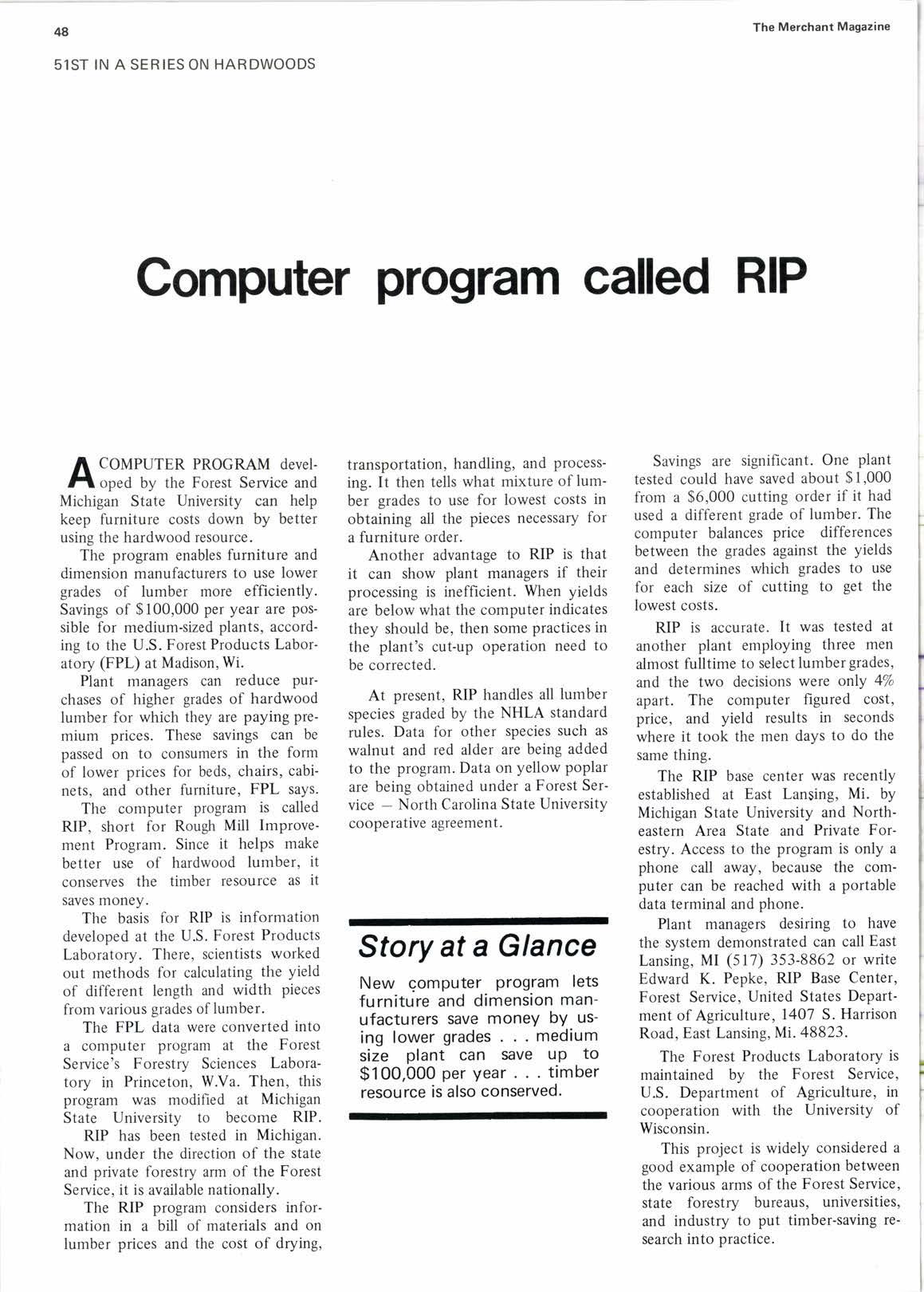
2 minute read
Gomputer program called RIP
An COMPUTER PROGRAM devel- oped by the Forest Service and Michigan State University can help keep furniture costs down by better using the hardwood resource.
The program enables furniture and dimension manufacturers to use lower grades of lumber more efficiently. Savings of $100,000 per year are possible for medium-sized plants, according to the U.S. Forest Products Laboratory (FPL) at Madison, Wi.
Plant managers can reduce purchases of higher grades of hardwood lumber for which they are paying premium prices. These savings can be passed on to consumers in the form of lower prices for beds, chairs, cabinets, and other furniture, FPL saYs.
The computer program is called RIP, short for Rough Mill ImProvement Program. Since it helps make better use of hardwood lumber, it conseryes the timber resource as it saves money.
The basis for RIP is information developed at the U.S. Forest Products Laboratory. There, scientists worked out methods for calculating the yield of different length and width pieces from various grades of lumber.
The FPL data were converted into a computer program at the Forest Service's Forestry Sciences Laboratory in Princeton, W.Va. Then, this program was modified at Michigan State University to become RIP.
RIP has been tested in Michigan. Now, under the direction of the state and private forestry arm of the Forest Service, it is available nationally.
The RIP program considers information in a bill of materials and on lumber prices and the cost of drying, transportation, handling, and processing. It then tells what mixture of lumber grades to use for lowest costs in obtaining all the pieces necessary for a furniture order.
Another advantage to RIP is that it can show plant managers if their processing is inefficient. When yields are below what the computer indicates they should be, then some practices in the plant's cut-up operation need to be corrected.
At present, RIP handles all lumber species graded by the NHLA standard rules. Data for other species such as walnut and red alder are being added to the program. Data on yellow poplar are being obtained under a Forest ServiceNorth Carolina State University cooperative agreement.
Story at a Glance
New qomputer program lets furniture and dimension manufacturers save money bY using lower grades . medium size plant can save uP to $100,000 per year timber resource is also conserved.
Savings are significant. One Plant tested could have saved about $1,000 from a $6,000 cutting order if it had used a different grade of lumber. The computer balances price differences between the grades against the yields and determines which grades to use for each size of cutting to get the lowest costs.
RIP is accurate. It was tested at another plant employing three men almost fulltime to select lumber grades, and the two decisions were only 4% apart. The computer figured cost, price, and yield results in seconds where it took the men days to do the same thing.
The RIP base center was recently established at East Lansing, Mi. by Michigan State University and Northeastern Area State and Private Forestry. Access to the program is only a phone call away, because the computer can be reached with a portable data terminal and phone.
Plant managers desiring to have the system demonstrated can call East Lansing, MI (517) 353-8862 or write Edward K. Pepke, RIP Base Center, Forest Service, United States Department of Agriculture, 1407 S. Harrison Road, East Lansing, Mi.48823.
The Forest Products Laboratory is maintained by the Forest Service, U.S. Department of Agriculture, in cooperation with the University of Wisconsin.
This project is widely considered a good example of cooperation between the various arms of the Forest Service, state forestry bureaus, universities, and industry to put timber-saving re' search into oractice.










